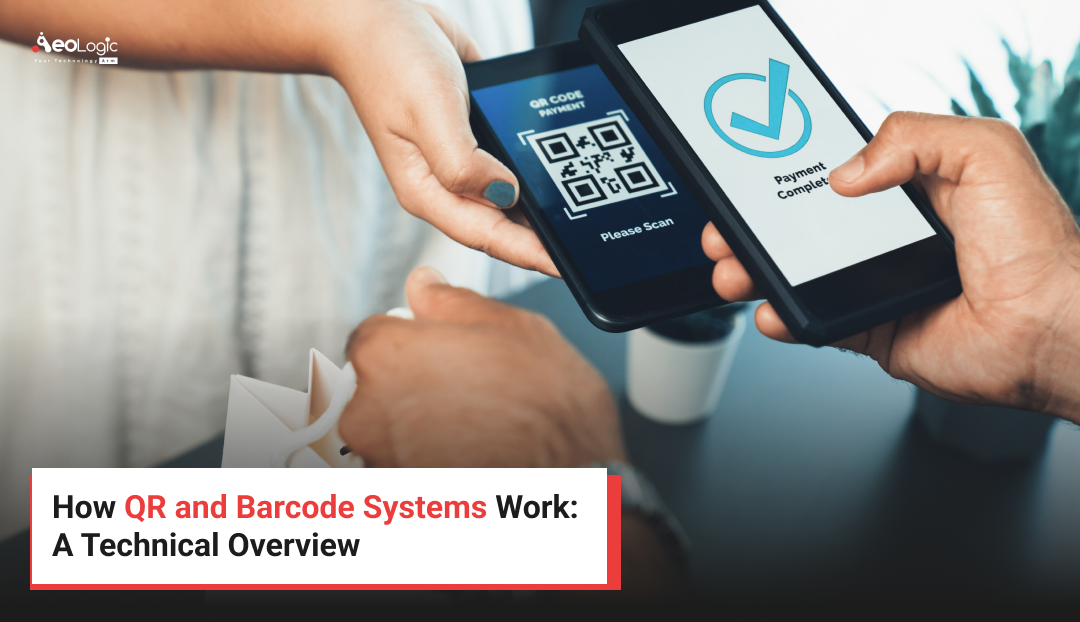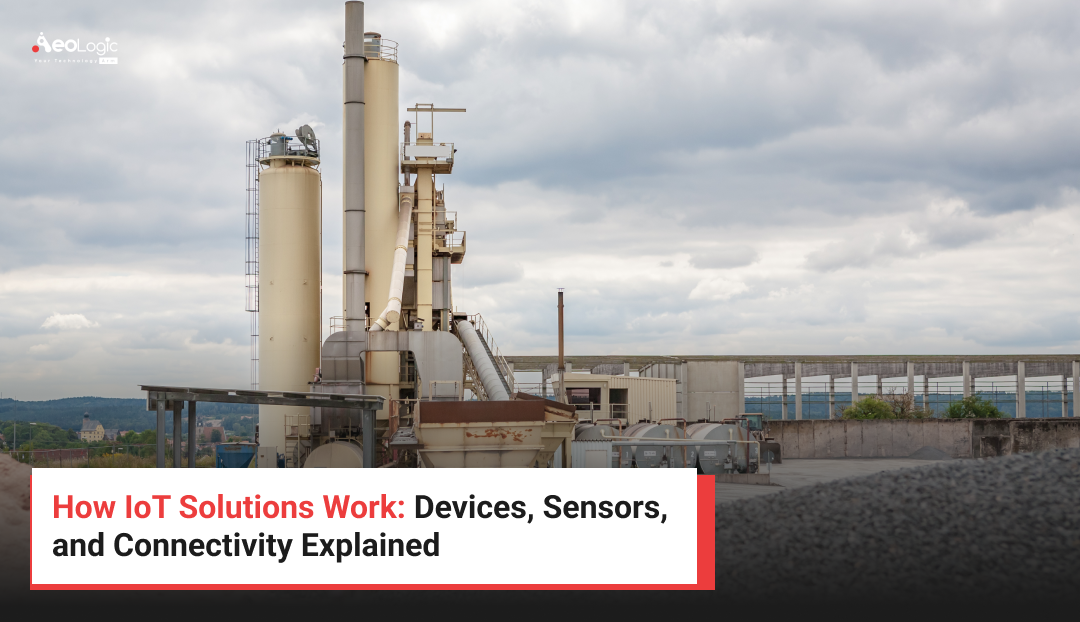Automation is no longer optional for modern businesses. As organizations continue to handle massive volumes of data daily, manual entry and traditional methods are proving inefficient and error-prone. To overcome these challenges, companies are increasingly adopting AIDC (Automatic Identification and Data Capture) technologies. AIDC simplifies how businesses collect, process, and integrate data by using advanced tools such as barcode scanners, RFID tags, QR codes, and biometric systems. These technologies make data management faster, more accurate, and more reliable. To understand the real impact of AIDC, we first need to explore how AIDC solutions work — from the moment data is collected to when it’s fully integrated into enterprise systems.
What is AIDC and Why It Matters
AIDC stands for Automatic Identification and Data Capture, which refers to the methods and technologies that automatically identify objects, collect data about them, and feed that data directly into computer systems without manual entry.
Instead of typing or writing down details, AIDC systems use machine-readable codes or signals to capture information instantly. This reduces human errors, saves time, and ensures data accuracy.
The importance of AIDC has grown rapidly as industries continue to move toward automation and digital transformation. In manufacturing, healthcare, logistics, and retail, AIDC plays a key role in tracking products, verifying authenticity, and maintaining transparent records.
Technologies that power AIDC include:
-
Barcode Scanners: Capture printed barcode data and translate it into digital form.
-
RFID (Radio Frequency Identification): Uses electromagnetic fields to identify and track tags on objects automatically.
-
Biometric Systems: Record fingerprints, facial features, or iris patterns for identity verification.
-
Smart Cards and Magnetic Stripes: Used for access control and secure transactions.
-
Optical Character Recognition (OCR): Converts printed text or images into digital information.
AIDC solutions have become essential for any business seeking efficiency, accuracy, and traceability.
Key Components of AIDC Systems
Before understanding how AIDC solutions work, it’s important to know the key components that make up a complete AIDC ecosystem. Each component plays a critical role in automating data flow.
1. Data Capture Devices
Devices such as barcode scanners, RFID readers, or biometric scanners are used to identify and record information.
2. Tags, Labels, and Identifiers
Items being tracked are marked with barcodes, QR codes, or RFID tags, each containing unique information.
3. Middleware or Data Processing Software
Middleware acts as a bridge between the data capture devices and enterprise applications. It filters, formats, and transmits collected data to the appropriate system.
4. Communication Network
Wireless or wired networks (Wi-Fi, Bluetooth, or cellular) transmit the captured data from devices to servers or cloud platforms.
5. Database and Enterprise Integration Systems
Once data is received, it’s stored in databases or sent directly to ERP (Enterprise Resource Planning) and WMS (Warehouse Management Systems) platforms for analysis and reporting.
These elements together make AIDC a fully automated and integrated system for managing business information.
How AIDC Solutions Work: Step-by-Step Process
To understand how AIDC solutions work, let’s break it down into a clear process — from data capture to integration and analysis.
Step 1: Data Tagging and Identification
Each product, asset, or item is assigned a unique identifier, such as a barcode or RFID tag. This tag stores key information about the item — like its model number, batch, or location.
Step 2: Data Capture
A device, such as a scanner or reader, detects the tag or code and captures the stored data. For example, when a warehouse worker scans a product barcode, the device instantly retrieves product details.
Step 3: Data Transmission
Once captured, data is transmitted to a local server, cloud, or software system through wired or wireless communication networks.
Step 4: Data Processing and Validation
Middleware or software processes the collected data to remove duplicates, validate information, and ensure accuracy before integration.
Step 5: Data Integration
Processed data is automatically fed into enterprise systems like ERP, CRM, or WMS. This enables real-time updates, inventory tracking, and reporting without manual intervention.
Step 6: Analytics and Insights
Finally, integrated data is analyzed to generate insights — such as demand forecasts, supply chain performance, or equipment maintenance trends.
This end-to-end process shows how AIDC streamlines data handling, turning raw information into actionable intelligence within seconds.
Data Collection: The Foundation of AIDC
At the heart of every AIDC system lies data collection. This phase determines how effectively information will flow through the rest of the process.
Data collection in AIDC involves using automated devices to gather accurate information directly from physical items or environments. Unlike manual entry, AIDC collects this data automatically — reducing human effort and the risk of errors.
Common Methods of Data Collection:
-
Barcode Scanning: The most common form of data capture, used for product identification, inventory management, and sales tracking.
-
RFID Reading: Enables remote data collection without direct line of sight. Multiple items can be scanned simultaneously, making it ideal for warehouses.
-
Biometric Identification: Captures unique biological traits for secure access or verification.
-
Smart Labels and QR Codes: Provide detailed digital information accessible via mobile or industrial scanners.
Advantages of Automated Data Collection:
-
Instant capture of accurate data
-
Minimal manual effort and errors
-
Real-time tracking and updates
-
Seamless synchronization with digital systems
For example, in logistics, an RFID reader automatically records when goods leave or enter a warehouse. This eliminates the need for manual logging and ensures real-time visibility of assets.
Data Transmission and Processing
Once data is captured, the next stage in how AIDC solutions work is transmission and processing.
The captured information is transferred to central databases or cloud servers using communication networks. The method of transmission depends on the infrastructure — Wi-Fi, Bluetooth, Ethernet, or cellular networks are commonly used.
Processing of Data:
Raw data captured from devices is often unstructured. Middleware filters and formats this data before sending it to enterprise applications. For instance, a barcode scanner in a store sends product data to an inventory management system, which updates stock levels instantly.
Real-Time Communication:
AIDC systems allow real-time synchronization between devices and databases. This enables businesses to access live updates — such as stock movement, equipment location, or sales activity — without delay.
This continuous data flow ensures that every part of the organization operates on accurate, up-to-date information.
Integration with Enterprise Systems
The final stage of how AIDC solutions work involves integrating the processed data into larger enterprise systems for analysis and decision-making.
Integration connects AIDC platforms with ERP, CRM, and WMS software, ensuring that the data collected in one area automatically updates across the business ecosystem.
For example:
-
When a product is scanned during shipping, the ERP system updates inventory automatically.
-
When a patient’s biometric record is verified in a hospital, the system logs it under their electronic health record.
-
When raw materials are received in manufacturing, data flows into both inventory and quality management systems.
This automated integration eliminates manual updates and ensures consistency across all departments.
Benefits of Integration:
-
Real-time visibility across all business units
-
Centralized data storage and management
-
Improved coordination between departments
-
Accurate reporting and analytics
AIDC integration not only streamlines workflows but also transforms business operations into intelligent, connected ecosystems.
Benefits of AIDC in Modern Industries
The impact of AIDC on modern industries is massive. Once integrated properly, these systems provide a wide range of benefits that enhance efficiency and accuracy.
1. High Accuracy and Reliability
AIDC eliminates human errors and ensures that the data captured is correct the first time.
2. Time Efficiency
Automated data collection significantly reduces the time spent on manual entry and verification.
3. Real-Time Insights
AIDC allows instant updates, giving businesses visibility into operations at every level.
4. Enhanced Productivity
By automating repetitive tasks, employees can focus on more strategic work.
5. Cost Reduction
Although AIDC requires an initial investment, it cuts long-term operational costs through improved efficiency and reduced waste.
6. Better Compliance and Security
AIDC systems maintain audit trails, ensure data traceability, and enhance security through authentication technologies.
7. Scalability
Businesses can easily scale AIDC systems to handle increasing volumes of data without additional manpower.
These benefits explain why companies in manufacturing, logistics, healthcare, and retail are shifting to AIDC to stay competitive.
Real-World Applications of AIDC Solutions
AIDC technology is no longer limited to warehouses or factories. It has become an essential part of how organizations in every industry capture, manage, and use data. Here are some key sectors where AIDC has transformed operations.
1. Manufacturing
Manufacturers rely on AIDC to track raw materials, monitor assembly lines, and ensure product quality. RFID tags and barcode scanners provide real-time updates on production stages, enabling factories to maintain efficiency and traceability.
AIDC also helps detect quality issues early, manage maintenance schedules, and ensure compliance with safety standards. With automation, manufacturing plants can operate faster and more accurately than ever before.
2. Retail and E-Commerce
In retail, AIDC powers everything from product labeling to inventory tracking. Barcode scanners speed up checkout processes, while RFID tags track stock movement between warehouses and stores.
E-commerce companies depend heavily on AIDC for accurate order picking, real-time stock visibility, and faster delivery management. Automated tracking minimizes errors and enhances customer satisfaction through precise, on-time deliveries.
3. Logistics and Supply Chain
AIDC is the backbone of logistics operations. RFID and barcode technologies track shipments, monitor goods in transit, and record storage conditions automatically.
With AIDC, businesses gain complete visibility across supply chains — from sourcing to delivery. It helps identify bottlenecks, reduce losses, and optimize routes, ensuring timely and efficient deliveries.
4. Healthcare
Accuracy and traceability are crucial in healthcare, and AIDC plays a vital role in achieving both. Barcodes and RFID tags track medical equipment, patient records, and medication administration. Biometric systems ensure secure patient identification and prevent duplication or misidentification errors.
By automating data capture, healthcare institutions can enhance patient safety, streamline workflows, and maintain precise medical histories.
5. Agriculture and Livestock Management
Farmers use RFID tags and AIDC tools to track livestock health, monitor feeding, and record growth patterns. Smart sensors also collect data on soil, temperature, and weather conditions, helping farmers make data-driven decisions that improve yield and efficiency.
6. Government and Public Administration
Governments use AIDC technologies such as biometric identification and smart cards for voter registration, ID verification, and access control. These systems ensure security, transparency, and faster service delivery to citizens.
7. Automotive and Aerospace
Both industries depend on AIDC to manage complex supply chains, track parts, and ensure quality compliance. Each component can be identified and traced through its entire lifecycle, improving safety, reliability, and regulatory compliance.
In short, AIDC solutions have become a universal foundation for digital efficiency across all sectors.
Cost to Implement AIDC Systems
The cost of implementing AIDC solutions varies based on the type of technology, scale, and business requirements. However, it is often a one-time investment that pays off through long-term efficiency and accuracy gains.
1. Hardware and Devices
Barcode scanners, RFID readers, printers, and biometric devices form the core of AIDC systems. Basic barcode scanners start from around $100, while advanced industrial RFID readers may cost between $1,000 and $5,000 depending on features and range.
2. Tags and Labels
Barcodes and QR codes are inexpensive, costing just a few cents each. RFID tags, however, range from $0.10 to $5 depending on type and data capacity.
3. Software and Integration
Middleware and integration with ERP or WMS software may range between $10,000 and $100,000, depending on the level of customization required.
4. Network Infrastructure
Implementing wireless or cloud connectivity may require investment in routers, mobile devices, or servers to ensure smooth data transmission.
5. Maintenance and Training
Regular maintenance, software updates, and staff training are essential for ensuring long-term efficiency. These typically cost around 10–15% of the total system investment annually.
Although these figures can vary, businesses that implement AIDC typically achieve ROI within 12 to 24 months, thanks to reduced labor costs, fewer errors, and improved productivity.
Future Trends of AIDC Solutions
The future of AIDC looks promising as new technologies continue to make data capture more intelligent and connected. Here are some emerging trends that will define how AIDC evolves in the coming years.
1. AI and Machine Learning Integration
Combining AI with AIDC will make data systems predictive rather than reactive. AI can analyze captured data patterns to forecast equipment failures, predict customer demand, or detect anomalies automatically.
2. IoT Connectivity
The integration of AIDC with IoT devices will allow for real-time monitoring and analytics on a much larger scale. Connected sensors and RFID systems will provide deeper visibility into asset tracking and supply chain operations.
3. Blockchain-Based Data Security
Blockchain will enhance AIDC data integrity by creating secure, tamper-proof records. This will be crucial for industries like logistics, healthcare, and finance, where transparency and authenticity are critical.
4. Mobile-First AIDC Solutions
As workforces become more mobile, handheld devices and smartphones with built-in scanners will enable data capture from anywhere. Cloud-based AIDC systems will sync automatically, providing real-time visibility across locations.
5. Edge Computing and Faster Processing
Edge computing will process data locally before sending it to the cloud, reducing latency and increasing response time — especially for real-time applications such as manufacturing and logistics.
6. Green and Sustainable AIDC
The future will also see more energy-efficient devices and recyclable tags to align with global sustainability goals.
7. Biometric Advancements
Biometric technologies will become more advanced and widely used for secure identification in industries like healthcare, banking, and government.
These trends show that AIDC is not just about automating data capture — it’s about creating a smarter, more connected ecosystem for global industries.
Final Words
Understanding how AIDC solutions work provides a clear picture of how businesses today are simplifying data management and driving automation. From data collection and transmission to integration and analytics, AIDC systems eliminate inefficiencies that manual methods can’t overcome.
Every stage — from capturing information using scanners or RFID tags to integrating it with enterprise systems — helps build a faster, more accurate, and more reliable workflow.
Whether it’s tracking inventory, verifying identities, or managing complex supply chains, AIDC ensures that organizations have real-time visibility and actionable insights at their fingertips.
As technology continues to advance, AIDC will remain a crucial pillar in the digital transformation journey.
If your business is ready to move beyond manual processes and embrace automation, get in touch with Aeologic Technologies today to explore how our innovative AIDC solutions can help you streamline operations, reduce errors, and achieve greater productivity.
FAQs
1. What is AIDC technology?
AIDC (Automatic Identification and Data Capture) is a technology that automatically collects and enters data into computer systems using devices like barcode scanners, RFID tags, and biometric readers.
2. How do AIDC solutions work?
AIDC works by tagging items with barcodes or RFID tags, capturing data through scanning devices, transmitting it via networks, processing it with software, and integrating it into enterprise systems for real-time visibility.
3. What are the benefits of using AIDC systems?
AIDC improves accuracy, reduces manual errors, increases efficiency, and provides real-time data insights for faster decision-making.
4. What industries use AIDC solutions the most?
AIDC is widely used in manufacturing, retail, logistics, healthcare, agriculture, and government sectors for tracking, automation, and security.
5. How is AIDC different from manual data entry?
Unlike manual entry, AIDC automates data collection and eliminates human error, making it faster and more reliable.
6. What technologies are used in AIDC?
Key technologies include barcode scanning, RFID, biometric recognition, smart cards, and optical character recognition (OCR).
7. How much does it cost to implement AIDC?
The cost varies depending on hardware, software, and integration requirements, but most businesses recover their investment within 1–2 years through operational savings.
8. Can AIDC be integrated with existing systems?
Yes, AIDC systems can be integrated with ERP, CRM, and WMS platforms to ensure smooth and automated data flow across departments.
9. Is AIDC secure?
Yes. AIDC includes security protocols such as encryption, authentication, and blockchain-based verification to prevent data breaches or tampering.
10. What is the future of AIDC technology?
The future of AIDC lies in combining AI, IoT, blockchain, and edge computing to create more intelligent, connected, and efficient data ecosystems.

Passionate about breaking down complex tech into simple ideas. Covers everything from AI and software development to gadgets and emerging tech trends.






